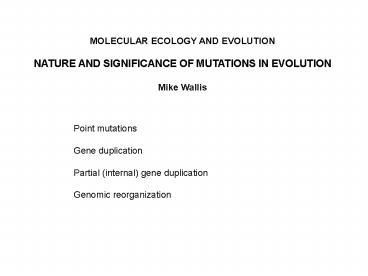MOLECULAR ECOLOGY AND EVOLUTION PowerPoint PPT Presentation
1 / 22
Title: MOLECULAR ECOLOGY AND EVOLUTION
1
MOLECULAR ECOLOGY AND EVOLUTION NATURE AND
SIGNIFICANCE OF MUTATIONS IN EVOLUTION Mike
Wallis
Point mutations Gene duplication Partial
(internal) gene duplication Genomic
reorganization
2
NATURE AND SIGNIFICANCE OF POINT MUTATIONS
- point mutations and protein evolution
cytochrome c - rates of evolution proteins
- rates of evolution DNA
- episodic variation in the rate of evolution
- point mutations that have a large effect
3
CYTOCHROME c An example of accumulation of
point mutations during evolution Sequence
comparisons Constant features Variable
features - even distribution across
sequence Neutral theory - constant evolutionary
rate? (the idea of the molecular clock)
4
5
(No Transcript)
6
BUT - ADAPTIVE EVOLUTION DOES HAPPEN So
not all changes can be neutral
- Even for cytochrome c, not everything fits for
the neutral theory - Distribution of substitutions in the 3D structure
- Replacement of yeast cyt c gene by horse cyt c
gene - Variable rate of evolution
7
Cytochrome c (reduced)
8
RATES OF EVOLUTION
Conventional view that the rate of evolution is
usually constant for any one protein, but varies
widely between proteins Differences between
proteins are due to different strengths of
purifying selection
9
(No Transcript)
10
RATES OF PROTEIN EVOLUTION
Rate of
Evolution Fibrinopeptides 9.0 Luteinizing
hormone ?-chain 3.0 Lactalbumin 2.7 Ribonuclease
2.1 Serum albumin 1.9 Haemoglobin
?-chain 1.2 Lysozyme 1.0 Myoglobin 0.9 Trypsi
n 0.6 Insulin 0.4 Cytochrome
c 0.2 Glutamate dehydrogenase
0.09 Histone 0.01 _____________________________
____________ Substitutions/ amino acid site/
109 years
11
From Nei 1987
12
- RATES OF EVOLUTION AT THE DNA LEVEL
- Rates within a gene may vary considerably
- Coding region (nonsynonymous substitutions)
- Coding region (synonymous substitutions)
- 5 and 3 sequences
- introns
- (pseudogenes)
13
(No Transcript)
14
RATES OF EVOLUTION (nonsynonymous and synonymous
substitutions)
The ratio of the nonsynonymoussynonymous
substitution rates (Ka/Ks or dn/ds) in a
protein-coding sequence has been widely used to
detect positive selection. Normally Ka/Ks is
ltlt 1, since synonymous substitutions are mostly
neutral and nonsynonymous substitutions are
mostly deleterious and removed by purifying
selection. If Ka/Ks 1, this may indicate
neutral substitution associated with loss of
function. If Ka/Ks gt 1, the only explanation is
positive selection
15
RATES OF EVOLUTION (nonsynonymous and synonymous
substitutions)
Substitutions/nucleotide site/109
years Non-Syn Syn Immunoglobulin VH
1.07
5.7 Haemoglobin ?
0.56
3.9 Haemoglobin ?
0.87
3.0 Insulin
0.16
5.4 Histone H4
0.004 1.4
16
ARE RATES OF MOLECULAR EVOLUTION CONSTANT?
Synonymous substitution rate (Ks) Much evidence
suggests that Ks varies between groups. For
example Ks in rodents is 2-3 x that in apes.
This may be a consequence of generation
times Nonsynonymous substitution rate (Ka) The
neutral theory holds that Ka is normally constant
for any one protein, but varies from one protein
to another, as tables shown earlier imply. But
there are many exceptions, including
insulin haemoglobin cytochrome c
growth hormone (and many other polypeptide
hormones) lysozyme histones
ribonuclease-related genes (after gene
duplication)
17
PHYLOGENETIC TREE FOR MAMMALIAN GHS
GP
Chevrotain
Marmoset
Loris
Dolphin
Horse
Elephant
Man
Alpaca
Ox
Sheep
Goat
Dog
Rat
Mouse
Rabbit
Rhesus
Hamster
Possum
Deer
Pig
0
0
0
2
0
0
2
1
1
2
4
12
3
3
0
7
0
2
1
0
25
0
4
2
3
12
Million years before present
17
76
50
11
2
7
0
0
75
Rate of evolution
slow phase 0.32
5
ruminants (rapid phase) 3.9 Primates (rapid
phase) 22.2
_______________________ substitutions/aa
site/109yr
100
18
EVOLUTION OF LYSOZYME IN HIGHER PRIMATES
From Messier Stewart (1997)
19
RAPID EVOLUTION OF SELECTED NERVOUS SYSTEM GENES
IN PRIMATES
After Dorus et al (2004)
20
ADAPTIVE SIGNIFICANCE OF POINT MUTATIONS CONCLUSI
ON
Many recently studies indicate that a substantial
proportion of amino acid substitutions that are
accepted into proteins are adaptive
(non-neutral). Such substitutions are often
introduced during short episodes of accelerated
evolution, which in many cases can be related to
functional changes.
21
POINT MUTATIONS THAT HAVE A BIG EFFECT
- Haemoglobin S - heterosis
- Chain termination mutants - chain elongation
- e.g. Haemoglobin Constant Spring -
elongated C- terminus (lethal as homozygote) - luteinizing hormone (LH) and human
chorionic gonadotropin (hCG)
- Mutations at splice sites
22
Alternative splicing of human GH mRNA precursor

